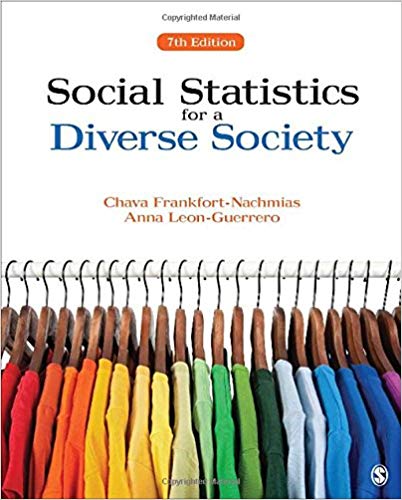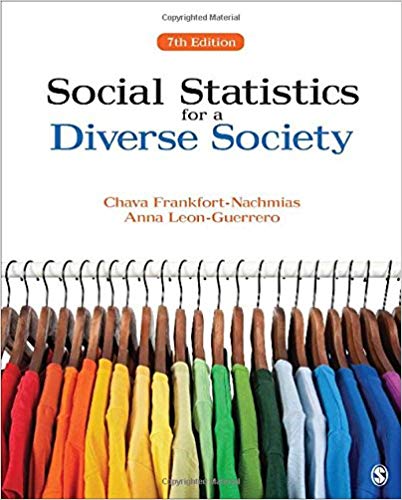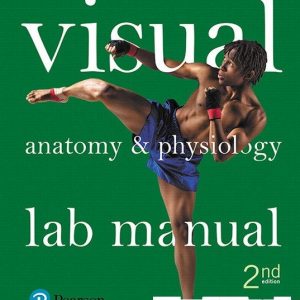This is completed downloadable of Test Bank for Social Statistics for a Diverse Society Seventh Edition

Product Details:
- ISBN-10 : 148333354X
- ISBN-13 : 978-1483333540
- Author:
Today’s students live in a world characterized by a growing diversity and richness of social differences. In the seventh edition of Social Statistics for a Diverse Society, authors Chava Frankfort-Nachmias and Anna Leon-Guerrero continue to help students learn statistics through real research examples related to the dynamic interplay of race, class, gender, and other social variables. Focusing on the constant intersections between local and global social concerns and methods of inquiry and investigation, this new edition continues to emphasize intuition and common sense while demonstrating the link between the practice of statistics and important social issues. In addition, guides for reading and interpreting the research literature help students understand key statistical concepts, while SPSS demonstrations and a rich variety of exercises help them hone their problem-solving skills.
Table of Content:
- CHAPTER 1 • The What and the Why of Statistics
- The Research Process
- Asking Research Questions
- The Role of Theory
- Formulating the Hypotheses
- Independent and Dependent Variables: Causality
- Independent and Dependent Variables: Guidelines
- Collecting Data
- Levels of Measurement
- Nominal Level of Measurement
- Ordinal Level of Measurement
- Interval-Ratio Level of Measurement
- Cumulative Property of Levels of Measurement
- Levels of Measurement of Dichotomous Variables
- Discrete and Continuous Variables
- → A Closer Look 1.1: A Cautionary Note: Measurement Error
- Analyzing Data and Evaluating the Hypotheses
- Descriptive and Inferential Statistics
- Evaluating the Hypotheses
- Examining a Diverse Society
- → A Closer Look 1.2: A Tale of Simple Arithmetic: How Culture May Influence How We Count
- Learning Statistics
- → Data at Work
- CHAPTER 2 • The Organization and Graphic Presentation of Data
- Frequency Distributions
- Proportions and Percentages
- Percentage Distributions
- The Construction of Frequency Distributions
- Frequency Distributions for Nominal Variables
- Frequency Distributions for Ordinal Variables
- Frequency Distributions for Interval-Ratio Variables
- Cumulative Distributions
- → A Closer Look 2.1: Real Limits, Stated Limits, and Midpoints of Class Intervals
- Rates
- Reading the Research Literature: Access to Public Benefits
- Graphic Presentation of Data
- The Pie Chart
- The Bar Graph
- The Histogram
- The Statistical Map
- The Line Graph
- The Time-Series Chart
- Statistics in Practice: Foreign-Born Population 65 Years and Over
- → A Closer Look 2.2: A Cautionary Note: Distortions in Graphs
- → Data at Work: Kurt Taylor Gaubatz: Graduate Program in International Studies
- CHAPTER 3 • Measures of Central Tendency
- The Mode
- The Median
- Finding the Median in Sorted Data
- An Odd Number of Cases
- An Even Number of Cases
- Finding the Median in Frequency Distributions
- Locating Percentiles in a Frequency Distribution
- The Mean
- → A Closer Look 3.1: Finding the Mean in a Frequency Distribution
- Understanding Some Important Properties of the Arithmetic Mean
- Interval-Ratio Level of Measurement
- Center of Gravity
- Sensitivity to Extremes
- Reading the Research Literature: The Case of Reporting Income
- Statistics in Practice: The Shape of the Distribution
- The Symmetrical Distribution
- The Positively Skewed Distribution
- The Negatively Skewed Distribution
- Guidelines for Identifying the Shape of a Distribution
- → A Closer Look 3.2: A Cautionary Note: Representing Income
- Considerations for Choosing a Measure of Central Tendency
- Level of Measurement
- Skewed Distribution
- Symmetrical Distribution
- → Data at Work: Ben Anderstone: Political Consultant
- CHAPTER 4 • Measures of Variability
- The Importance of Measuring Variability
- The Index of Qualitative Variation
- Steps for Calculating the IQV
- Expressing the IQV as a Percentage
- Statistics in Practice: Diversity in U.S. Society
- The Range
- The Interquartile Range
- The Box Plot
- The Variance and the Standard Deviation
- Calculating the Deviation From the Mean
- Calculating the Variance and the Standard Deviation
- Considerations for Choosing a Measure of Variation
- → A Closer Look 4.1: More on Interpreting the Standard Deviation
- Reading the Research Literature: Community College Mentoring
- → Data at Work: Sruthi Chandrasekaran: Senior Research Associate
- CHAPTER 5 • The Normal Distribution
- Properties of the Normal Distribution
- Empirical Distributions Approximating the Normal Distribution
- Areas Under the Normal Curve
- Interpreting the Standard Deviation
- An Application of the Normal Curve
- Transforming a Raw Score Into a Z Score
- The Standard Normal Distribution
- The Standard Normal Table
- 1. Finding the Area Between the Mean and a Positive or Negative Z Score
- 2. Finding the Area Above a Positive Z Score or Below a Negative Z Score
- 3. Transforming Proportions and Percentages Into Z Scores
- Finding a Z Score That Bounds an Area Above It
- Finding a Z Score That Bounds an Area Below It
- 4. Working With Percentiles in a Normal Distribution
- Finding the Percentile Rank of a Score Higher Than the Mean
- Finding the Percentile Rank of a Score Lower Than the Mean
- Finding the Raw Score Associated With a Percentile Higher Than 50
- Finding the Raw Score Associated With a Percentile Lower Than 50
- Reading the Research Literature: Child Health and Academic Achievement
- → A Closer Look 5.1: Percentages, Proportions, and Probabilities
- → Data at Work: Claire Wulf Winiarek: Director of Collaborative Policy Engagement
- CHAPTER 6 • Sampling and Sampling Distributions
- Aims of Sampling
- Basic Probability Principles
- Probability Sampling
- The Simple Random Sample
- The Systematic Random Sample
- The Stratified Random Sample
- The Concept of the Sampling Distribution
- The Population
- → A Closer Look 6.1: Disproportionate Stratified Samples and Diversity
- The Sample
- The Dilemma
- The Sampling Distribution
- The Sampling Distribution of the Mean
- An Illustration
- Review
- The Mean of the Sampling Distribution
- The Standard Error of the Mean
- The Central Limit Theorem
- The Size of the Sample
- The Significance of the Sampling Distribution and the Central Limit Theorem
- Statistics in Practice: The 2016 U.S. Presidential Election
- → Data at Work: Emily Treichler: Postdoctoral Fellow
- CHAPTER 7 • Estimation
- Point and Interval Estimation
- Confidence Intervals for Means
- → A Closer Look 7.1: Estimation as a Type Inference
- Determining the Confidence Interval
- Calculating the Standard Error of the Mean
- Deciding on the Level of Confidence and Finding the Corresponding Z Value
- Calculating the Confidence Interval
- Interpreting the Results
- Reducing Risk
- Estimating Sigma
- Calculating the Estimated Standard Error of the Mean
- Deciding on the Level of Confidence and Finding the Corresponding Z Value
- Calculating the Confidence Interval
- Interpreting the Results
- Sample Size and Confidence Intervals
- Statistics in Practice: Hispanic Migration and Earnings
- → A Closer Look 7.2: What Affects Confidence Interval Width?
- Confidence Intervals for Proportions
- Determining the Confidence Interval
- Calculating the Estimated Standard Error of the Proportion
- Deciding on the Desired Level of Confidence and Finding the Corresponding Z Value
- Calculating the Confidence Interval
- Interpreting the Results
- Reading the Research Literature: Women Victims of Intimate Violence
- → Data at Work: Laurel Person Mecca: Research Specialist
- CHAPTER 8 • Testing Hypotheses
- Assumptions of Statistical Hypothesis Testing
- Stating the Research and Null Hypotheses
- The Research Hypothesis (H1)
- The Null Hypothesis (H0)
- Probability Values and Alpha
- → A Closer Look 8.1: More About Significance
- The Five Steps in Hypothesis Testing: A Summary
- Errors in Hypothesis Testing
- The t Statistic and Estimating the Standard Error
- The t Distribution and Degrees of Freedom
- Comparing the t and Z Statistics
- Hypothesis Testing With One Sample and Population Variance Unknown
- Hypothesis Testing With Two Sample Means
- The Assumption of Independent Samples
- Stating the Research and Null Hypotheses
- The Sampling Distribution of the Difference Between Means
- Estimating the Standard Error
- Calculating the Estimated Standard Error
- The t Statistic
- Calculating the Degrees of Freedom for a Difference Between Means Test
- The Five Steps in Hypothesis Testing About Difference Between Means: A Summary
- → A Closer Look 8.2: Calculating the Estimated Standard Error and the Degrees of Freedom (df) When the Population Variances Are Assumed to Be Unequal
- Statistics in Practice: Vape Use Among Teens
- Hypothesis Testing With Two Sample Proportions
- Reading the Research Literature: Reporting the Results of Hypothesis Testing
- → Data at Work: Stephanie Wood: Campus Visit Coordinator
- CHAPTER 9 • Bivariate Tables
- How to Construct a Bivariate Table
- How to Compute Percentages in a Bivariate Table
- Calculating Percentages Within Each Category of the Independent Variable
- Comparing the Percentages Across Different Categories of the Independent Variable
- → A Closer Look 9.1: How to Deal With Ambiguous Relationships Between Variables
- Reading the Research Literature: Racial Disparities and Educational Attainment
- The Properties of a Bivariate Relationship
- The Existence of the Relationship
- The Strength of the Relationship
- The Direction of the Relationship
- Elaboration
- Testing for Nonspuriousness: Firefighters and Property Damage
- An Intervening Relationship: Religion and Attitude Toward Abortion
- Conditional Relationships: More on Abortion
- The Limitations of Elaboration
- Reading the Research Literature: The Digital Divide
- → Data at Work: Spencer Westby: Senior Editorial Analyst
- CHAPTER 10 • The Chi-Square Test and Measures of Association
- The Concept of Chi-Square as a Statistical Test
- The Concept of Statistical Independence
- The Structure of Hypothesis Testing With Chi-Square
- The Assumptions
- Stating the Research and the Null Hypotheses
- The Concept of Expected Frequencies
- Calculating the Expected Frequencies
- Calculating the Obtained Chi-Square
- The Sampling Distribution of Chi-Square
- Determining the Degrees of Freedom
- Making a Final Decision
- Review
- Statistics in Practice: Respondent and Mother Education
- → A Closer Look 10.1: A Cautionary Note: Sample Size and Statistical Significance for Chi-Square
- Proportional Reduction of Error
- → A Closer Look 10.2: What Is Strong? What Is Weak? A Guide to Interpretation
- Lambda: A Measure of Association for Nominal Variables
- Cramer’s V: A Chi-Square-Related Measure of Association for Nominal Variables
- Gamma and Kendall’s Tau-b: Symmetrical Measures of Association for Ordinal Variables
- Reading the Research Literature: India’s Internet-Using Population
- → Data at Work: Patricio Cumsille: Professor
- CHAPTER 11 • Analysis of Variance
- Understanding Analysis of Variance
- The Structure of Hypothesis Testing With ANOVA
- The Assumptions
- Stating the Research and the Null Hypotheses and Setting Alpha
- The Concepts of Between and Within Total Variance
- The F Statistic
- → A Closer Look 11.1: Decomposition of SST
- Making a Decision
- The Five Steps in Hypothesis Testing: A Summary
- Statistics in Practice: The Ethical Consumer
- → A Closer Look 11.2: Assessing the Relationship Between Variables
- Reading the Research Literature: College Satisfaction Among Latino Students
- → Data at Work: Kevin Hemminger: Sales Support Manager/ Graduate Program in Research Methods and Statistics
- CHAPTER 12 • Regression and Correlation
- The Scatter Diagram
- Linear Relationships and Prediction Rules
- Finding the Best-Fitting Line
- → A Closer Look 12.1: Other Regression Techniques
- Defining Error
- The Residual Sum of Squares (Σe2)
- The Least Squares Line
- Computing a and b
- → A Closer Look 12.2: Understanding the Covariance
- Interpreting a and b
- A Negative Relationship: Age and Internet Hours per Week
- Methods for Assessing the Accuracy of Predictions
- Calculating Prediction Errors
- Calculating r2
- Testing the Significance of r2 Using ANOVA
- Making a Decision
- Pearson’s Correlation Coefficient (r)
- Characteristics of Pearson’s r
- Statistics in Practice: Multiple Regression and ANOVA
- → A Closer Look 12.3: Spurious Correlations and Confounding Effects
- Reading the Research Literature: Academic Intentions and Support
- → Data at Work: Shinichi Mizokami: Professor
- Appendix A. Table of Random Numbers
- Appendix B. The Standard Normal Table
- Appendix C. Distribution of t
- Appendix D. Distribution of Chi-Square
- Appendix E. Distribution of F
- Appendix F. A Basic Math Review
- Learning Check Solutions
- Answers to Odd-Numbered Exercises
- Glossary
- Notes
- Index





